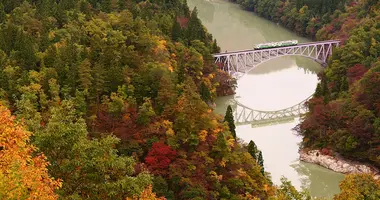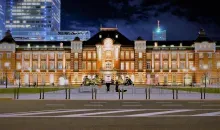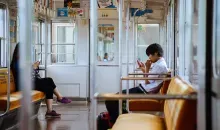How to get from Osaka to Hiroshima
These two major cities in the more southern portion of Honshu Island are some of the most eccentric destinations in all of Japan. Both have a rich history and a fair share of attractions to visit. In Hiroshima, be sure to visit all the sites that were constructed in commemoration of the atomic bomb attack at the end of World War II, and in Osaka, countless neighborhoods are home to backstreets jam packed with lively izakayas and restaurants. Especially with these two cities, it’s important to be aware of the rivaling iterations of Okonomiyaki; the Osaka version is dense and mixed, while the Hiroshima version is more layered in its construction, with grilled soba noodles on the bottom. Be sure to try both and pick a favorite!
Getting from Osaka to Hiroshima via Shinkansen bullet train
Hiroshima Station
Getting from Osaka to Hiroshima with the Shinkansen
Osaka and Hiroshima are not particularly far from each other and are directly connected via the Shinkansen bullet train network. Travelers can ride the Nozomi Shinkansen bullet train, the Mizuho Shinkansen bullet train, the Hikari bullet train, or the Sakura Shinkansen bullet train, all of which are part of the Tokaido-Sanyo Shinkansen line. From Osaka, passengers will depart from Shin-Osaka Station and arrive at Hiroshima Station. Tickets cost just under 10,000 yen, though this will change depending on whether a seat reservation is made. The trip is covered by the Japan Rail Pass for the Hikari and Sakura Shinkansen; however, for the faster Nozomu and Mizuho Shinkansen, there will be an additional fee for pass users of 4,170 yen. The journey spans 400 km (250 miles) and takes around 1 to 1 and a half hours.
Different types of Shinkansen bullet trains available on this itinerary:
| Hikari Shinkansen Bullet Train | Kodama Shinkansen Bullet Train | Nozomi Shinkansen Bullet Train | Mizuho Shinkansen Bullet Train |
*NOTE: All Shinkansen bullet trains on the Tokaido-Sanyo Line are accessible with the Japan Rail Pass; however, an additional fee of 4,170 yen is required to ride the Nozomi and Mizuho trains from Shin-Osaka to Hiroshima.
Reserve tickets for Osaka to Hiroshima!
Reserving seats on the Shinkansen
On Shinkansen bullet trains, individual ticket holders and Japan Rail Pass holders can reserve seats in advance of boarding. Reservations are typically not required for Shinkansen bullet trains because they frequently have non-reserved cars with seats available on a first-come, first-served basis. These are often the car numbers 1-4.
On certain trains, reservations are required for every car. However, it is highly recommended that all travelers try to book tickets during the busiest travel seasons in Japan, which are the spring and the New Year's holiday. When buying a single ticket, a reserved seat costs extra, but Japan Rail Pass holders are free of this charge.
Oversized baggage on the Shinkansen
A variety of requirements must be fulfilled in order for passengers with large suitcases to board the bullet train. According to Japan Railway regulations, luggage over 160 cm in length, width, and height needs to be checked into the special bulky baggage section at the back of the train car. Owners of such bags must additionally make reservations for seats near this section. Please be advised that you cannot board the Shinkansen with luggage that are larger than 250 cm overall.
Baby carriages, musical instruments in cases, and sporting goods (bikes, snowboards, etc.) in cases are exempt from the baggage restrictions.
Exploring Osaka
The most populated city in Kansai and the third most populous city in all of Japan is Osaka, which is renowned for its vibrant environment, mouthwatering street food, and quirky residents. Most people consider Tokyo to be Osaka's companion city—or rival city, depending on who you ask. Travelers to Japan often visit both cities and contrast their experiences there; the simplest way to do this is to simply take the Shinkansen bullet train to travel back and forth between each place.
Tourists love to visit the bustling central Osaka neighborhoods of Umeda, Namba, and Dotonbori because of their unique Japanese urban setting and plenty of various enterprises. The running Glico Man in Dotonbori, sometimes called the Osaka emblem, is a well-known photo spot with a view of the area's famed bridge. Still near the city center, Honmachi is a more relaxed neighborhood, so you won't have to travel far to find a more muted atmosphere if you want to get away from the bustle and congestion.
Osaka is a city well-known for its lively atmosphere, but it's also a great destination to visit for art and culture. The renowned “Tower of the Sun” (太陽の塔) was constructed by artist Taro Okamoto because the city hosted the World's Expo in 1970. The tower is still on exhibit for people to view and is located at Expo Park. For those who are interested in even more ancient history, a must-see site is the Mozu Tombs, which is home to a collection of kofun (burial tombs) from the fifth century.
For those who are interested in even more ancient history, a must-see site is the Mozu Tombs, which is home to a collection of kofun (burial tombs) from the fifth century. These ancient burial grounds are a rare historic site among the modern buildings inside the Osaka metropolitan area. From above, the burial grounds take on different shapes and sizes, with the larger ones resembling key holes.
The primary servicing station for passengers traveling to and from Osaka via Shinkansen will be Shin-Osaka Station, a more modern station constructed in 1964 to manage the country's first Shinkansen bullet train operation. Nearby Kiyasuso Hanpo is worth checking out. It's well known for its unusually shaped rectangular mitarashi dango—roasted, chewy mochi covered in sweet sauce. Inside Shin-Osaka Station, Chikira House is a specialized shop that sells Nissin Chicken Ramen products. Get ramen-flavored soft serve ice cream, savory appetizers, and Osaka-specific souvenirs. A unique delight that will surely remain in your memory throughout your visit to Osaka!
Exploring Hiroshima
Hiroshima, the capital of the prefecture of the same name, is a city that has been permanently etched in history books. In the twenty-first century, Hiroshima has evolved into a symbol of progress, peace, and culture by fully embracing its recent and ancient past. There is no lack of activities in Hiroshima for those who appreciate rich history, cuisine, and waterfront views.
Hiroshima is home to several well-known landmarks that have been built and preserved to honor the victims of the disaster as well as the location of the first atomic bomb attack. Many of these memorials may be located in Hiroshima Peace Memorial Park, one of which is the “A-Bomb Dome,” a domed building that was the only one that remained within the bomb radius. Since then, the building has been mostly preserved, with damage to the upper part appearing to be stuck in time.
Hiroshima's unique culinary culture, which actually originated in large part in the period following the atomic bomb and the Second World War, is another major draw for tourists. A savory cooked batter dish with a variety of mix-ins, Hiroshima-style Okonomiyaki differs significantly from its equally famous Osaka version, primarily in that it is layered in construction and has soba noodles on the bottom. This dish was primarily created due to the scarcity of ingredients following the war, but it has since blossomed into a specialty that is enjoyed by both Hiroshima locals and tourists. Anago (sea eel), which is raised in the abundant seas surrounding the city, and fresh, meaty oysters are two other well-known Hiroshima delicacies.
There are some hidden treasures worth exploring off the coast of Hiroshima. The view of Miyajima Shrine, which is well-known for its "floating" torii gate that rises out of the water during high tide and is particularly lovely at sunset, is one of the most iconic in all of Hiroshima. The shrine itself, which has been around for centuries and is regarded as a global cultural site, is the major attraction, though. Animal enthusiasts will welcome Okunoshima, an island a little distance away where about 1,000 wild rabbits graze freely. The island has a variety of amenities, including a hotel and cafe for overnight stays.
Taking the Tokaido-Shinkansen to Hiroshima Station is the necessary transportation while traveling to Hiroshima from Shin-Osaka Station. You’ll have plenty of leg room and the opportunity to buy a premium "eki-ben," a bento box designed specifically for long-distance train travel, to munch on while you take in the passing countryside.
See some of the best of western Japan!
As two prominent cities in western Japan that are in reasonable proximity, heading to Hiroshima after a fun time in Osaka is sure to be a great highlight for your trip to Japan! This journey is made easy with the Shinkansen—fast, easy, and convenient! Be sure to book your ticket with or without a seat reservation, or look into getting a Japan Rail Pass to travel between the two cities in addition to practically every destination you could think of throughout Japan!














